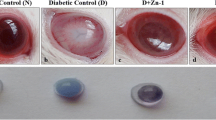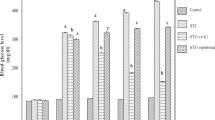Abstract
Previous studies have demonstrated that administration of pyruvate prevents cataract formation in diabetic rats. It is known that the induction of cataractous process in this case is initiated by aldose reductase (AR) catalyzed synthesis and accumulation of excessive sorbitol in the lens fibres and epithelium and their consequent osmotic hydration. Synthesis of this and other polyols is competitively inhibited by pyruvate. The objective of the present investigations was hence to determine whether pyruvate would have a similar protective effect in species where cataract formation is relatively independent of sorbitol synthesis such as in humans where the lens AR activity is extremely low, especially with glucose as a substrate. The Km of AR for glucose is known to be very high. The possible protective effect of pyruvate in the low AR models was conceived on the basis of our previous findings suggesting that it can also exert substantial antiglycating as well as antioxidant effects. The present studies have hence been conducted with mice, a species known to be low in lens AR, similar to that in humans. As stipulated, pyruvate administration has indeed been found to offer a significant protection against development of diabetic cataract in this model also. The effect correlated with the inhibition of protein glycation as well as of oxidative stress. The latter was apparent by the prevention of the loss of glutathione known to be associated with diabetes. Although there was a small but noticeable increment in the sorbitol content of the diabetic lenses, this was osmotically insignificant. Even this increase was prevented by pyruvate. The magnitude of the elevation in the contents of glycated proteins and the depression in the level of glutathione were, on the contrary, highly pronounced, suggesting a more prominent role of the latter factors. In addition, the possibility of a direct metabolic support it could offer to the tissue is also imminent by its effect on the maintenance of ATP, as shown earlier. The present studies are therefore considered more relevant to the pathogenesis of cataract in human diabetics and its possible prevention by endogenous compounds with antiglycating and antioxidant properties. Inhibition of cataract formation by pyruvate in an animal model with low lens AR, similar to that in humans, has been shown for the first time. (Mol Cell Biochem 269: 115–120, 2005)
Similar content being viewed by others
References
Kahn HA, Leibowitz HM, Ganley JP, Kini MM, Colton T, Nickerson RS, Dawber TR: The Framingham eye study I. Outline and major prevalence finding. Am J Epidemiol 106: 17–32, 1977
Stark WJ Jr, Maumenee AE, Fagadau W, Datiles M, Baker CC, Worthen D, Klein P, Auer C: Cystoid macular edema in pseudophakia. Surv Ophthalmol 28 suppl : 442–451, 1984
Fine BS, Brucker AJ: Macular edema and Cystoid macular edema. Am J Ophthalmol 92: 466–481, 1981
Clayman HM, Jaffe NS, Light DS, Jaffe MS, Cassady JC: Intraocular lenses, axial length, and retinal detachment. Am J Ophthalmol 92: 778–780, 1981
Smith PW, Stark WJ, Maumenee AE, Enger CL, Michels RG, Glaser BM, Bonham RD: Retinal detachment after cataract extraction with posterior chamber intraocular lens. Ophthalmology 94: 495–504, 1987
Kinoshita JH: Mechanisms initiating cataract formation. Invest Ophthalmol Vis Sci 13: 713–724, 1974
Varma SD, Mikuni I, Kinoshita JH: Flavonoids as inhibitors of lens aldose reductase. Science 188: 1215–1216, 1975
Varma SD, Mizuno A, Kinoshita JH: Diabetic cataracts and flavonoids. Science 195: 205–206, 1977
Chylack L, Henriques HF, Cheng HM, Tung WH: Efficacy of alrestatin, an aldose reductase inhibitor, in human diabetic and non-diabetic lenses. Ophthalmology 86: 1579–1585, 1979
Kador PF: The role of aldose reductase in the development of diabetic complications. Med Res Rev 8 3 : 325–52, 1988
Hegde KR, Henein MG, Varma SD: Establishment of the mouse as a model animal for the study of diabetic cataracts. Ophthal Res 35: 12–18, 2003
Hegde KR, Henein MG, Varma SD: Establishment of mouse as an animal model for study of diabetic cataracts: Biochemical studies. diabetes, obesity and metabolism. 5: 113–119, 2003
Bhuyan KC, Bhuyan DK, Podos SM: Evidence of increased lipid peroxidation in cataracts. I. R. C. S. Med Sci 9: 126–127, 1981
Monnier VM, Steven VJ, Cerami A: Non-enzymatic glycosylation, sulphydryl oxidation and high molecular weight aggregates of lens proteins in experimental sugar cataracts. J Exptl Med 50: 1098–1117, 1979
Perry RE, Swamy MS, Abraham EC: Progressive changes in lens crystallin glycation and high molecular weight aggregate formation leading to cataract development in Streptozotocin-diabetic rats. Exp Eye Res 52: 205–212, 1987
Hegde KR, Varma SD: Cataracts in Experimentally Diabetic Mouse: Morphological and Apoptotic Changes. Diabetes Obesity and Metabolism, in press.
Hegde KR, Varma SD: Morphogenetic and apoptotic changes in diabetic cataract. Prevention by pyruvate. Mol Cell Biochem 262: 233–237, 2004
Varma SD, Devamanoharan PS, Rutzen AR, Ali AH, Henein M: Attenuation of galactose-induced cataract by pyruvate. Free Rad Res 30: 253–263, 1999
Zhao W, Devamanoharan PS, Henein M, Ali AH, Varma SD: Diabetes-induced biochemical changes in rat lens: Attenuation of cataractogenesis by pyruvate. Diabetes Obesity Metab 2: 165–174, 2000
Varma SD, Hegde K, Henein M: Oxidative damage to mouse lens in culture. Protective effect of pyruvate. Biochim Biophys Acta 1621: 246–252, 2003
Zhao W, Devamanoharan PS, Varma SD: Fructose induced deactivation of Glucose-6-phosphate dehydrogenase activity and its prevention by pyruvate: Implications in cataract prevention. Free Rad Res 29: 315–320, 1998
Varma SD, Ramachandran S, Devamanoharan PS, Morris SM, Ali AH: Prevention of oxidative damage to rat lens by pyruvate in vitro: Possible attenuation in vivo. Curr Eye Res 14: 643–649, 1995
Varma SD, Chand D, Sharma YR, Kuck JF, Richards RD: Oxidative stress on lens and cataract formation: Role of light and oxygen. Curr Eye Res 3: 35–57, 1984
Varma SD, Kumar S, Richards RD: Light-induced damage to ocular lens cation pump. Prevention by vitamin C. Proc Natl Acad Sci U.S.A. 76: 3504–3506, 1979
Zigler JS, Goosey JD: Singlet oxygen as a possible factor in human senile nuclear cataract development. Curr Eye Res 3: 59–65, 1984
Spector A: The search for a solution to senile cataracts. Proctor lecture. Invest Ophthalmol Vis Sci 25: 130–146, 1984
Blakytny R, Harding JJ: Glycation non-enzymatic glycosylation inactivates glutathione reductase. Biochem J 288: 303–307, 1992
Author information
Authors and Affiliations
Corresponding author
Rights and permissions
About this article
Cite this article
Hegde, K.R., Varma, S.D. Prevention of cataract by pyruvate in experimentally diabetic mice. Mol Cell Biochem 269, 115–120 (2005). https://doi.org/10.1007/s11010-005-3087-z
Received:
Accepted:
Issue Date:
DOI: https://doi.org/10.1007/s11010-005-3087-z




